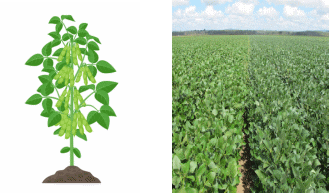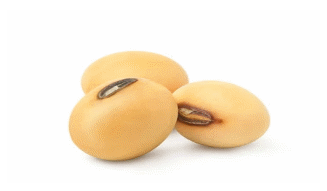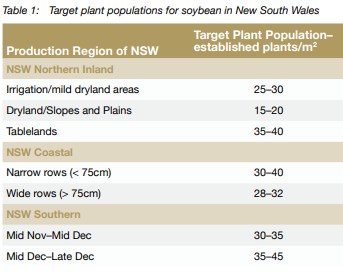Crop Profile
The soybean, a type of legume, is related to alfalfa, clover, and peas. Although soya is native to East Asia, it has been adapted to grow in the Australian climate. In 2020, Australia recorded average soybeans yield of around 1.6 metric tons per hectare (Granwal, 2021).
Physiological Traits
The soybean boasts particularly distinct physiological traits compared to other legumes. As Figure 1–2 shows, it is an erect branching plant capable of growing higher than two meters, thanks to its numerous vegetative stages – six to be exact (Grains Research & Development Corporation [GRDC], 2016, p. 4). Soya beans have white or a shade of purple self-fertilizing flowers. Each plant can produce 60 to 80 pods, containing an average of three pea-sized beans (American Soybean Association, 2017). While most commercial soya beans are brown or tan in color, bicolored, black, brown, green, and yellow seeds also exist.


Environmental Preferences and Main Growing Regions
The most suitable regions for growing soybeans in Australia are Victoria’s northern irrigation areas. These locations have warm summer temperatures and longer day lengths. Farmers in tropical areas can produce protein-rich legumes using stored and summer rainfall. Fortunately, years of research have enabled scientists to innovate soybean varieties that can be grown successfully in Australia’s diverse climates and latitudes. The Grains Research & Development Corporation (2016) report emphasizes the importance of selecting a variety recommended for a specific region.
Management Requirements
Land Preparation
Soybeans are relatively easy to manage, save for the paddock preparation stage. It is vital to ensure that the seedbed is weed-free before planting for rapid emergence. While the land preparation method is immaterial, it is advisable to opt for the most sustainable, feasible option.
Variety Selection
After careful preparation of the farm, a farmer needs to conduct pre-planting due diligence to identify the most suitable seed variety for their region. For example, Curringa, Djakal, and Snowy are suitable for Southern NSW and northern Victoria, whereas Cowrie and Ivory remain are recommended for the Macquarie and Lachlan irrigation in Central NSW (GRDC, 2016).
Inoculation
Soybean seeds need to be inoculated before sowing, at least in the Australian soil that lacks natural rhizobia, because it facilitates nodulation. Soybean plants need effectively formed nodules to optimize nitrogen intake. As GRDC (2016) recommends, seeds should be inoculated with Group H rhizobia a few hours before planting and inoculated seeds stored in the shade.
Planting
Soy seeds can rot when the water content is exceedingly high and fail to germinate when the soil is dry. Sowing at one’s earliest convenience, particularly after good rains, is always advisable. As Table 1 below shows, different growing regions and sowing times require varying plant populations. Moreover, while some varieties possess high water deficit tolerance, there is a need to prevent plants from experiencing moisture stress, especially when flowering begins and throughout pod development, filling, and physiological maturity phases – about 50–110 days after emergence (GRDC, 2016; Rima et al., 2019). Consulting a local crop agronomist or agricultural department is an excellent way to know the recommended sowing time and variety for an area.

Nutrition and Fertilizer
Soybean plants consume considerably large amounts of phosphorus (P) and Nitrogen (N) but also require sulfur (S) and zinc (Zn). However, do not apply N fertilizer to soybeans unless they fail to nodulate (GRDC, 2016).
Weed Control
Weed control in soybean cultivation is less taxing than many crops because the plants often out-compete weeds. Nevertheless, it is vital to remember that weeds pose the greatest threat to soy plants within the first eight weeks after emergence. A sustainable way for weed control is to aim for an even stand of the recommended plant population for the area in question. Alternatively, where broadleaf weeds become a menace, a farmer can always select a suitable herbicide from the broad range available in the market.
Harvesting
Soya beans are typically ready for harvesting and storage when their moisture content is around 12 to 13% (GRDC, 2016). Slowing ground speed to 4-5 km/hr and lowering the cutter bar closer to the ground are essential in minimizing losses due to shattering.
Main Disease and Pest Issues
Soybean plants are vulnerable to pest issues, including leaf-eating and cluster caterpillars, soybean aphids, pod-feeding pests – Melanacan and pod-sucking bugs – and mice. Researchers advocate for the use of integrated pest management (IPM) to prevent destructive organisms from reaching damaging levels and, when necessary, eliminate them without harming unthreatening creatures (GRDC, 2016; Heinrichs & Muniappan, 2018).
GRDC (2016) details the diseases to watch out for in soybeans, some of which are:
- wildfire,
- bacterial pustule,
- Sunburn,
- fungal diseases, e.g., pod and stem blight, rot, rust, and purple seed stain.
Soybean plants are immune or resistant to nearly all pathogens (GRDC, 2016). Practicing integrated disease management (IDM) can help keep plants healthy.
Market
Soybean is by many measures one of the most valuable vegetables in Australia, partly because it has evolved into an entire industry. Australian soybean seed is highly demanded in the crush market edible markets. Although the crush market accounts for about half of domestic soybean produce consumption, GRDC (2016) report notes that the edible market is growing. According to the Australian Oilseeds Federation (n.d.), the crop plays a fundamental role in sustaining Australia’s $2.5 billion oilseed industry. Moreover, regional economies rely heavily on the crop because it supports soybean processing facilities, food manufactures, input suppliers, and service providers.
The crop also helps farmers enrich the soil and offer disease breaks during crop rotation. Finally, Australian soybean farmers can tap into the growing global market currently dominated by only a few countries, including the U.S. and Brazil. In short, soybean is a highly sustainable crop because it enjoys tremendous economic viability locally and internationally, both presently underserved.
Reference List
American Soybean Association (2017) 2017 soystats: a reference guide to important soybean facts and figures. Web.
Australian Oilseeds Federation (n.d.) Soybean production: Australian soybean industry. Web.
Grains Research & Development Corporation (2016) Soybeans: northern region. Web.
Heinrichs, E.A. and Muniappan, R. (2018) ‘Integrated pest management for tropical crops: soybeans,’ CAB Reviews, 13(055), pp.1-44. Web.
Granwal, L. (2020) Yield of soybeans in Australia from financial year 2010 to 2021. Web.
Rima, I.A. et al. (2019) ‘Morpho-physiological traits of soybean as affected by drought,’ Bangladesh Agronomy Journal, 22(2), pp.41-54. Web.